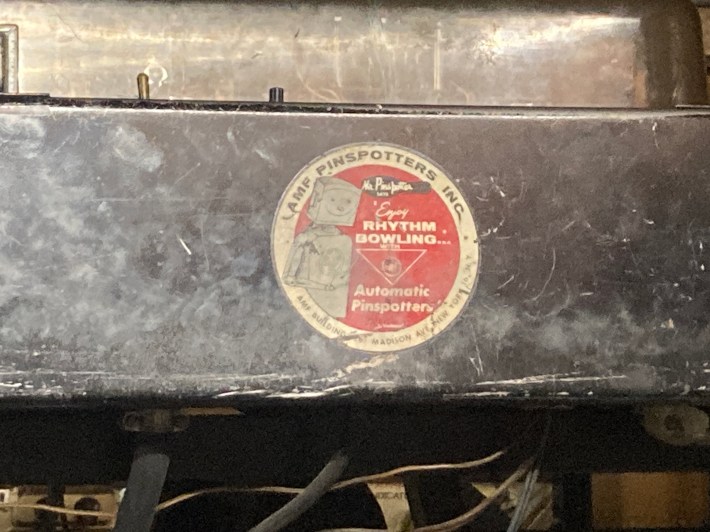You’re Goddamn Right I’m Livin’ in the Fuckin’ Past.
The year is 1960. The setting is Bryant Lake Bowl on Lake Street in Minneapolis, a former Ford dealership repurposed into an eight-lane bowling alley in the midst of the Great Depression. After being purchased by soon-to-be Minnesota Bowling Hall of Famer Bill Drouches a year prior, eight new automatic pinsetting machines manufactured by American Machine and Foundry (AMF) in Shelby, Ohio, whir and clank in the bowels of the lanes. In AMF’s advertising, they’re represented by a Jetsons-esque friendly robot, Mr. Pinspotter.
Fast-forward 65 years, and the front of house at Bryant Lake Bowl couldn’t be more different, although most of the changes are well-established. The game room full of pool tables and pinball machines has been a theater for over 30 years, and the pro shop—where bowlers would buy shoes and get their balls drilled—was converted to a kitchen at the same time. Drouches, quoted in a 1994 Strib article soon after he sold the business to local restaurateur Kim Bartmann, groused, “To me, it's not a bowling alley anymore. It's mostly a restaurant—whatever it is they [hipsters?] eat.”
Bowling on the whole has gone through several seismic shifts in the last 65 years. There was a suburban mega-center boom, the introduction of automatic scoring, cosmic bowling, and a recent private-equity-fueled consolidation with string pinsetters on the way. But with a few small exceptions, the bowling experience at BLB (including manual scoring) has survived virtually unchanged since Mr. Pinspotter’s arrival. Pinsetter mechanic Jim Quire is doing his damnedest to not only carry the torch, but to, in his words, “increase the standards of the bowling experience.”
Get a Job, Sir.
Quire only started his full-time position a month ago, but he's a bowling lifer, playing in leagues since he was nine years old. “[As a kid], my routine would be to bowl in my league and then go home and watch the pros on TV,” he recalls, “still wearing my jersey and everything."

He’s also been a longtime fixture at BLB. After being hired on as a dishwasher in 2008, initially lured by the siren song of free bowling, he spent a decade-plus handling (very) part-time mechanic duties (“just stopping in and putting out fires when I could”) while working full-time elsewhere. Most recently, he was a facility manager/lead mechanic for bowling chain Lucky Strike (formerly AMF).
When Quire tired of the corporate grind after several years in that role, he says current Bryant Lake Bowl owner Erica Gilbert asked him, “Don’t you just want to work here more?” It was music to his ears.
“I couldn’t be more grateful to her for offering me that job,” he says. “I’m relieved of the pressure of having to do things a certain way that aren’t the right way in a corporate setting, and I have the freedom to just make sure the place runs better. I’m doing restoration-level stuff that should have been done years ago.”
Sometimes You Eat the Bear, and Sometimes the Bear Eats You.
Both during his time at BLB and Lucky Strike, Quire was mentored by John Ellingson, one of the original AMF traveling mechanics from the ’60s (and former owner of now-defunct Lyn-Del Lanes in Bloomington). “I owe everything I’m doing now to John Ellingson,” Quire says. “Amongst mechanics, he’s legendary status, one of the best in the country. He was nice enough to let me look over his shoulder.”
Maintaining 65-year-old, largely obsolete equipment requires competence, ingenuity, and a little bit of luck. “It takes a little hoarding to make sure the right stuff isn’t going to run out,” Quire explains. For instance, a bowling alley in Le Sueur recently converted to new machines and was selling old parts. Quire rented a box truck and returned with a treasure trove, including a cache of hard-to-find motors, now precariously stocked in the rear of BLB. “I had that truck loaded until it was almost bottoming out,” he laughs.

There have been several major improvements to the AMF pinsetter technology since the machines were installed. First, electric eyes were added to detect a ball entering the pin area. “There used to be only cushion switches,” Quire explains, “but if there’s a little kid with an eight-pound ball, that won’t trigger the cushion switch.” Next, the original hard-wired stepper relay system, which progresses the pinsetter from one step to the next, was replaced by a circuit board (which were made by one company and are only repaired by one or two people in the country). “There are still two relays in there that start and stop the motors,” he notes, “but the circuit board tells them when to start and stop.” More recently, an improved pin delivery system, as well as motor timers to reduce wear and increase energy savings, were installed by Shaun Saldana, a traveling mechanic from Iowa.
Each lane is optimally stocked with 23 pins, in order to provide some extra weight in the machinery between frames when 10 pins are in the setter and 10 are on their way to it. Over the course of a single frame, there’s a 10-stage sequence from the first ball being delivered until the pins are set for the next bowler.
It’s a League Game, Smokey.
With his full-time involvement in maintenance, Quire has high hopes for the future. “There’s already been a drastic difference,” he says, “and I can tell it’s a weight off everyone’s shoulders, not having to deal with constant breakdowns or pin jams.”
Over the next few years, Quire predicts there’ll be a smoother bowling experience with better conditions at BLB. “And it’ll be easy for me to keep it that way once I’m caught up on decades of preventative maintenance and side work,” he laughs.
Increased reliability could come with other added benefits. “I’m just trying to fine-tune and catch up,” Quire says. “Then, once I feel like the machines are in a state where I’m confident enough to grow bowling, that’ll be another one of my focuses—getting a league going and hosting tournaments, things like that.”
For better and worse, the days of erratic pinsetter operation may be coming to an end. “Sometimes it’s fun to get bonus pins when they just tip over, but not everybody wants that!” Quire says.
Mark it eight, Dude.







